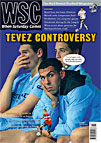 Roger Titford on the proposal to Oxford United and Reading in the early 1908s
Roger Titford on the proposal to Oxford United and Reading in the early 1908s
If megalomaniac tycoon and serial football chairman Robert Maxwell had not made two monstrous errors, there could well have been a Thames Valley United in Division Three in 1983-84 in place of Reading and his Oxford United. And, as David Lacey wrote in the Guardian at the time, “as a method of killing off two Football League clubs at a stroke the scheme surely has few rivals”.
There was an almost medieval cruelty in the sudden announcement of the merger plan – over a crackling PA system as the long-suffering 2,816 filed out of Elm Park after a 0-0 draw in April 1983. It was a completely unexpected concept and instant national news in an era when clubs very rarely even moved grounds or went bust. Meanwhile, in Oxford, Maxwell was being just as confrontational, stating if the scheme did not happen he would close down United and that opponents of the scheme would have more chance of “trying to make the Thames run backwards”. An unfortunate allusion given the tidal nature of the Thames but detail was clearly not Maxwell’s strong point.
His first error was his “obey or die” PR strategy which antagonised everyone but his own board and the Football League who, shamefully, gave approval in principle. His second error was to announce the merger before he had secured a majority of the shares in struggling Reading for a less than princely £200,000. More conventional and cautious business tactics could have brought him success before opponents had a chance to react.
The biggest faux pas of all was the idea that you could combine two clubs that were not just from different towns but different TV regions and create some free-floating attractive leisure facility. It was the same kind of science-fiction thinking that offered you a food pill in place of a three-course meal with your family – ultra-rational and completely missing the point. The Thames Valley is a geographical term, not a cultural construct. As a Reading boy educated at Oxford, I can safely say the places have little in common. There are hills in between. They are practically the same distance apart (nearly 30 miles) as Burnley and Bradford City, but no one has ever entertained the idea of Trans Pennine Clarets FC.
Thames Valley Royals is the name everyone remembers but the working title soon became Thames Valley United in deference to the greater power of Oxford in the deal. Didcot, a railway town closer to Oxford than Reading, expressed an interest in hosting the stadium while Maxwell rummaged for a site on the outskirts of Oxford. Oxford’s manager, Jim Smith, expected to take the merged job, so all in all there did not appear to be much in it for the Reading football public.
Oxford supporters, even though holding the less shitty end of the stick, were equally antagonised. Reading and Oxford fans protested vehemently about the ending of a century and of a couple of decades respectively of tradition. But they protested separately and did not work together in a Fans United-style approach. That was not just because of the existing rivalry but also the lack of a fan activism culture at the time.
The matter was resolved in the Reading boardroom anyway. The board split, the Reading patriots obtained an injunction against the machinations of the merger party and mobilised the small shareholder vote. At the crucial EGM in July 1983 Maxwell fell well short of getting a majority of the shares so former centre-forward Roger Smee emerged as Reading’s new owner. The merger crisis actually energised both clubs; both went on to win two promotions and a Wembley final in the next five years.
Maxwell continued to hold his minority shareholding in Reading until his presumed suicide in 1991 enabled the next Reading chairman, John Madejski, to acquire it. Since then this has essentially been a tale of two chairmen, the beneficent Madejski and the destructive Firoz Kassam at Oxford, shaping the differing fates of the clubs, such that on the day Reading beat Liverpool in the Premier League, Oxford were losing to Altrincham in non-League. There may be less of a gap now but the events of 1983 did not bring these “neighbours” emotionally any closer at all.
The hugely discredited, month-long Thames Valley Royals episode nevertheless found an echo four years later when a property company proposed “Fulham Park Rangers”, a merged entity which speaks for itself and whose constituent parts are now both in the Premier League. Mergers can work in the same city when there is more to gain than lose – Newcastle West End and East End forming Newcastle United or Inverness Caledonian and Thistle, for instance – but the calculation is far from straightforward and even the latter example is still tinged with controversy.
From WSC 297 November 2011